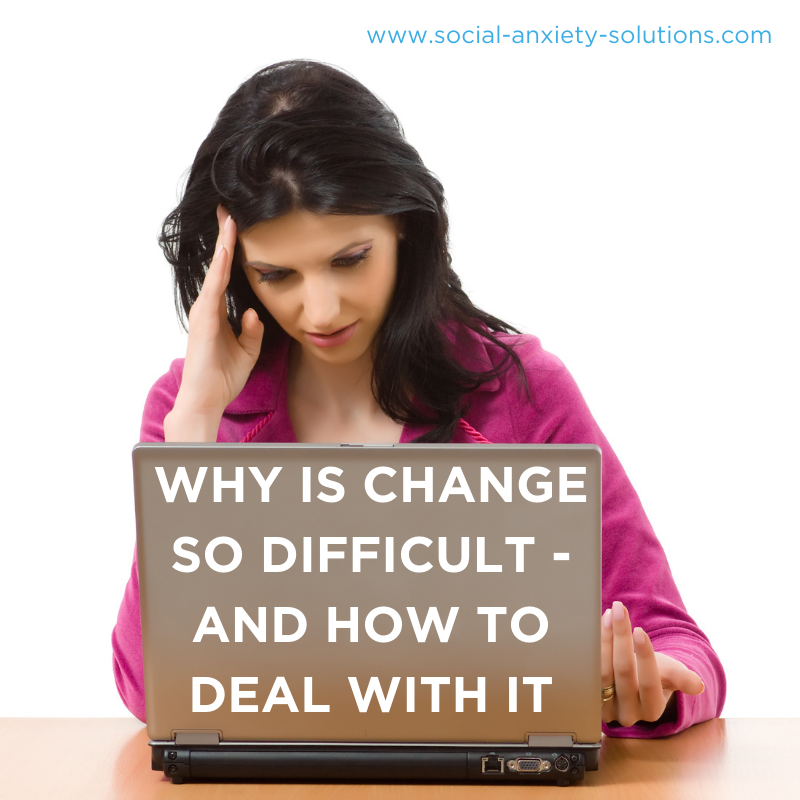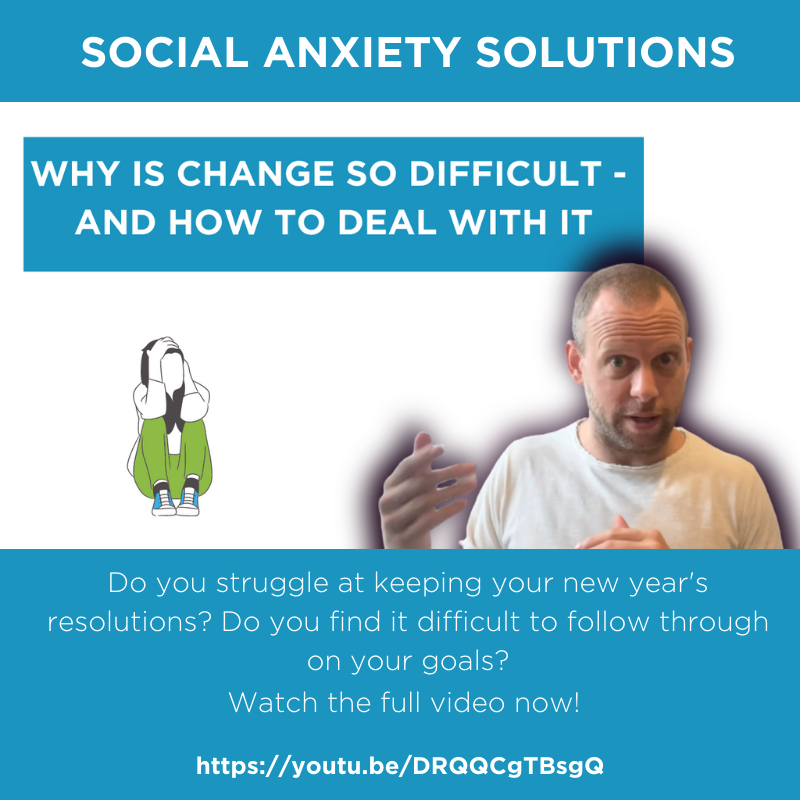SUMMARY
Do you struggle at keeping your new year’s resolutions?
Do you find it difficult to follow through on your goals?
In today’s episode, Sebastiaan explains the key concept behind this struggle.
He talks about:
– What makes change seem so difficult to achieve?
– What is resistance to change?
– What does upside (and downside) to change mean?
– How to uncover and get rid of these “downsides to change”?
Learn the techniques on how you can change towards being socially confident.
Be guided on how you can achieve your goal toward social ease.
Get my FREE starter kit by going to https://bit.ly/socialconfidencenow
FULL TRANSCRIPTION
What is the downside to change?
How is it keeping you socially anxious?
And how do you uncover it and get rid of it?
That’s what today is going to be about.
My name is Sebastiaan, from social-anxiety-solutions.com. I’m social confidence coach, and I answer questions like these.
And I got one that was sent in by Emre. And it goes something along the lines of this. I’m kind of paraphrasing it.
Hey, Sebastiaan, my current problem is letting go of resistance. I’ve managed to shift and change the perceived upsides to change. And now, I realize that when I’m socially confident, I won’t lose these upsides that I’m currently having as a result of the problem I’m dealing with, with social anxiety. But I have these downsides to change that I struggle with. And I don’t know how to handle these. Can you help me?
Well Emre, thank you for your question. And I hope so. Let’s see.
First of all, I need to give a little bit of perspective.
So what is the resistance to change?
Well, have you ever set a goal during New Year?
And did you accomplish that goal?
Now, if you did accomplish your goal, you’re one of the 8% (roughly) of people that does.
According to estimates, only 8% of people actually stick to their goal; stick to their new year’s resolution, and accomplish what they set out to accomplish.
As the statistics are not very good. So why is that?
Well, New Year comes along, and New Year’s resolution is formed: ‘okay, I’m going to lose weight, I’m going to be X pounds, that’s my ideal weight, and that’s what I’m going to weigh, or I’m going to be fit – I’m going to get a six-pack, or I’m going to advance my career or whatever it is, I’m going to do this every day. And I’m going to go to the gym this many times, I’m going to start yoga three times a week or whatever.’ — there’s a particular goal, New Year’s resolution, and they’re excited about it.
The first day comes along, they’re like, ‘yeah!’ — They get themselves ready for the gym, they go to the gym afterward, they feel great, like, Wow, look at me.’
2 days later to go to the gym – little bit less motivation, but they still feel good.
Then, the next time comes along, and motivation is not so high. They had a tough day, and they are like, I don’t know if I’m going to go.
And eventually, they’ll just stop.
So why is that?
Well, for one, they don’t have the proper psychology of change.
They don’t have successful psychology; they’re not set upright.
They don’t know how to hack it so that you can optimize your willpower.
That’s one thing.
But the other important thing is that they consciously want to accomplish this particular goal. But their subconscious mind is not on board with that.
So, your subconscious mind is the part of your brain that is in control 90 to 95% of the time. And it likes to keep the status quo – it likes to keep things the same. Because when everything is the same, even if it’s not preferred, even if you consciously don’t really prefer it, the subconscious likes to keep everything the way it is. Because that way you have control over it.
You do not have to deal with the unknown.
And the subconscious is the prime directive. Its main goal is survival; to make sure you survive. And when it doesn’t have to deal with the unknown, it’s easier to do that. It’ll just stay where you’re at.
So, given that there’s automatically a particular resistance to any kind of change you’re undertaking, and that resistance eventually, starts to manifest, and eventually it starts to be stronger than the willpower that you have.
So, you can overpower it with willpower for a little bit. But eventually, you’re going to run out of motivation, which is what happens for 92% of the people who set a goal.
The same thing happens when you set a goal of ‘I am going to get rid of this anxiety problem that I have in social situations, and I’m going to feel confident socially’. Your subconscious is going to go — Whoa, whoa, whoa, that’s a particular change I’m not on board with.
And since it’s 90% of the time in running the show, you’re going to have resistance.
So that’s the resistance that Emre is referring to.
Now, this is the general resistance. That’s general.
Any kind of change you want to undertake that’s big, that’s challenging, you’re going to have resistance to it.
But there’s also something called Specific Resistance to Change, it’s not called that I’ve made it up.
But just to be able to talk about it with more clarity, and that specific resistance to change can be an upside to not changing. Well, if I stay socially anxious, if I keep this problem in my life, I don’t have to follow through on these responsibilities. And I can stay indoors, and I don’t have to have a lot of time for myself. This is what I sometimes hear.
And so these are upsides to staying where you’re at.
Now, these need to be shifted and altered, which is what Emre has done. And like he writes, he says, I can see that after having done his work, I can see that when I’m socially confident, I will keep these upsides.
So, for example, he realizes that he can still say No to whenever he’s invited to a party, and he can keep as much ‘me time’ as he likes. And yet, he can be socially at ease and enjoy the other things as well. So, you will have more balance in his life.
But he’s talking about how he’s struggling with addressing the downsides to change.
Now, what is the downside to change?
Let’s take it to another realm. So, it may be easier for you to understand.
If you want to lose weight, say you’re significantly overweight, say you’re like 30 kilos overweight, and you want to lose 30 kilos, and maybe your ideal weight is, I don’t know, 60 kilos. (I don’t know what’s that in pounds, but probably something like 130 is my guests on 140 pounds, whatever) Say that that’s your ideal weight.
Now, you want to lose that weight – that’s your New Year’s resolution, and you instantly have resistance to that. The general resistance.
But you then also have specific resistance, that specific resistance can be an upside to not changing which could be I can eat whatever the hell I want to eat, I can eat cakes all day long, etc.
That’s an upside to not changing.
And there can also be a downside to changing – Well when I lose the weight, and I’m 30 kilos lighter, then maybe my chubby friends are going to criticize me, and my clothes won’t fit me anymore, and I will have to buy new clothes. And maybe I’ll get harassed by men again. And I don’t want that.
So there are downsides to change.
And as long as there are downsides to change, then there is pain associated with the outcome that you’re after.
And your brain, your subconscious mind moves away from pain and towards pleasure, and it more strongly moves away from pain.
So, you need to neutralize the pain associated with the outcome of social ease.
That’s what a downside is.
Once you’ve uncovered a particular downside, your goal is to neutralize that.
If you want to lose weight, and you are a woman that’s 30 kilos overweight, and you’re one of your concerns is, well, my chubby friends are going to be jealous of me or they going to make fun of me, they’re going to pick on me.
You can imagine that happening. And then as you imagine it happening, it’s going to bring up the pain because your brain doesn’t distinguish between something visually imagined, something vividly imagined or visualized, or something real.
So, you close your eyes, you imagine them actually being upset with you, or mocking you, or being jealous of you, and so on.
And you notice the feelings that that brings up in your body, that’s the emotional pain that I’m talking about.
And now that becomes your tapping target.
And then that is what you can then neutralize.
Now, this is just a simple explanation. Of course, there are particular techniques to do that. There are things that you need when you get stuck, you know, troubleshooting, but that’s an hour-long video. This is a little short blip to give you some tips.
So Emre, I hope that’s helpful. You know, for social confidence, you ask yourself, well, what’s the downside to being socially at ease?
Or other questions might be, what do I expect might be difficult once I’m socially at ease?
And you might have a similar thing?
Well, people will start challenging me. That’s often a fantasy that my clients have. Sometimes it can be real, but usually, it isn’t.
But okay, so if you think that people are going to say he’s faking it now look at him being confident, he’s is always that anxious guy.
All right.
You can imagine that happening. Notice how that feels in your body, notice the thoughts, the emotionalized thoughts that are coming up for you, and do your tapping while you’re focusing on that.
Neutralize that pain until you can imagine that happening, and it doesn’t bother you.
Now you’ve neutralized the potential downside.
And then you can repeat the question, hey, what’s the downside to being socially at ease? Or what do I expect to be difficult or hard or horrible?
And uncover the next downside.
By turning these downsides by neutralizing them, you’re getting rid of a NO to change – a specific No to change on your subconscious mind.
And that, as a result, lowers the resistance, eventually, you have no resistance left. And then change is so much easier.
That’s what sets you up for lasting change. That’s what you’re after.
Now, this is Sebastiaan from social-anxiety-solutions.com
If this was helpful for you, great, leave a comment; If you have any questions.
To learn more about how to specifically overcome your resistance, how to uncover downsides, work through them, how to use tapping to overcome your social anxiety, get my free social confidence starter kit on my website.
You can go to social-anxiety-solutions.com
Click on the button that says overcome SA for free. Or look at the banner that you see popping up, I’m sure. And you’ll put your email address in there and hit OK or send or yes, send me this stuff or whatever it says. And you’ll get that in your inbox right away.
And within two minutes, you can be tapping along with me as I guide you through a bunch of videos to experience the power of tapping and also some five-minute-long educational videos on how to use tapping to start reducing your social anxiety today.
So go to social-anxiety-solutions.com and I’ll talk to you very soon. Bye for now.
If you experience Social Anxiety, click below to receive the FREE “7 Secrets to Social Confidence” Mini Course!
- How To Stop Worrying - January 17, 2024
- How to Reduce Facial Blushing with EFT Tapping? - June 29, 2023
- Are You Scared to Get Anxious? Here’s how to fix it! - June 16, 2023



